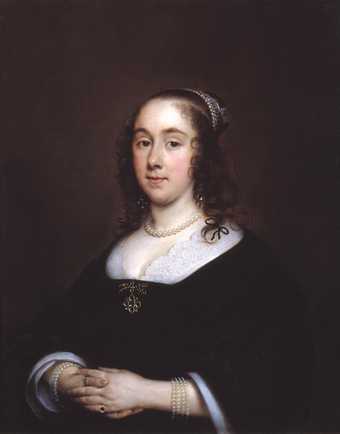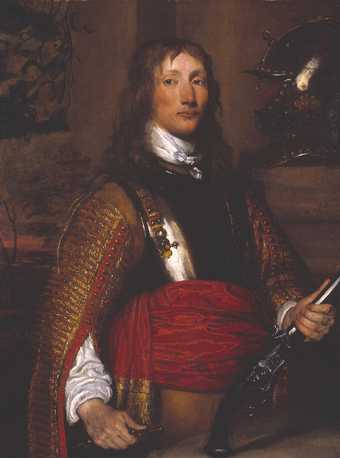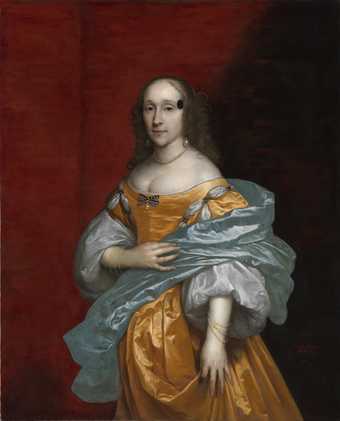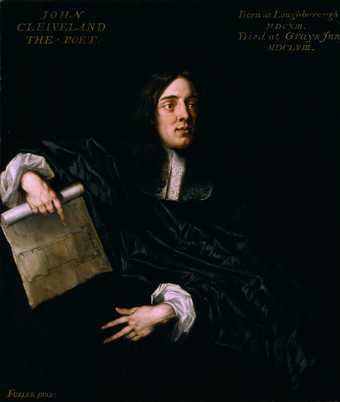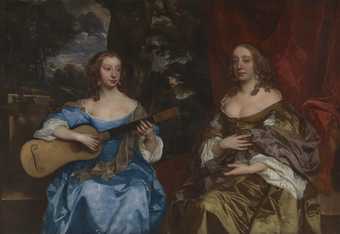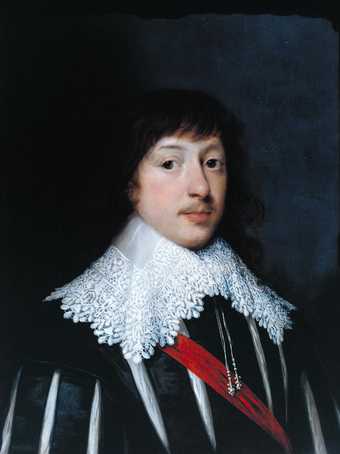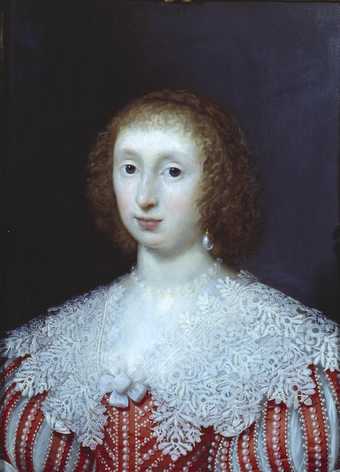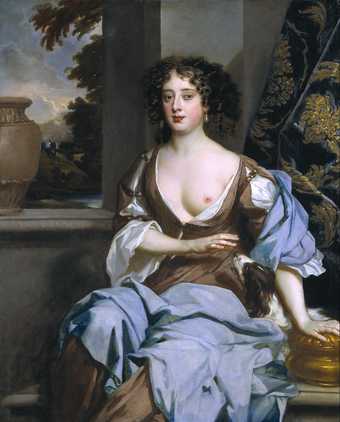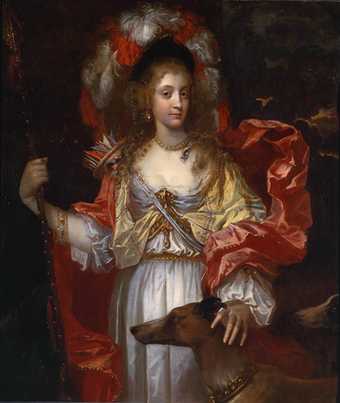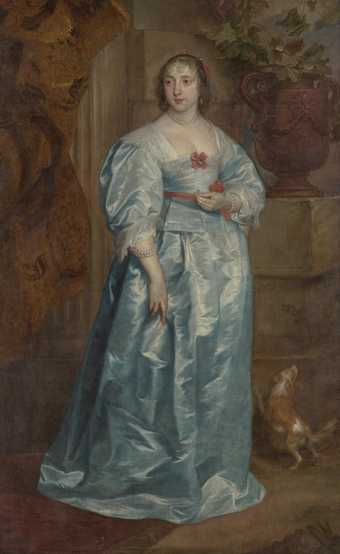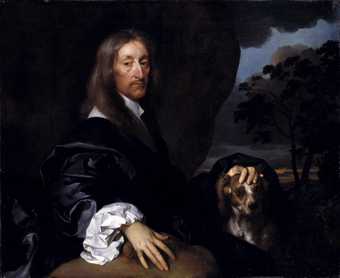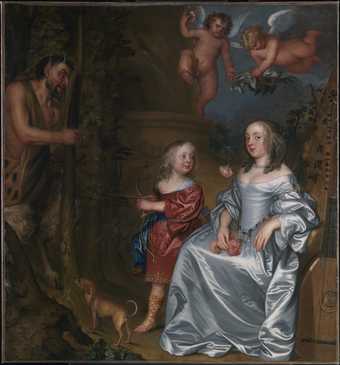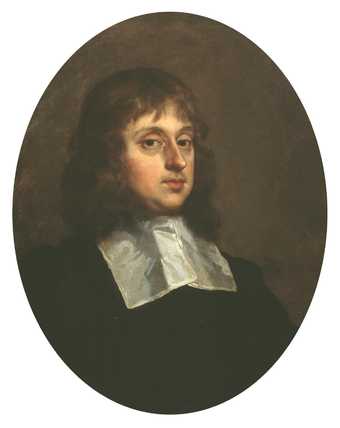
- Artist
- Joan Carlile c.1606–1679
- Medium
- Oil paint on canvas
- Dimensions
- Support: 1107 × 900 mm
frame: 1205 × 1012 × 73 mm - Collection
- Tate
- Acquisition
- Presented by Tate Patrons 2016
- Reference
- T14495
Summary
This portrait depicting an unknown woman was made in 1650–5 by Joan Carlile, one of the earliest British female artists to work professionally in oil. The figure is shown full-length, wearing a white satin dress and standing in a rocky landscape setting, which opens onto a distant view of a sunset river valley to the right. The portrait has been cut down slightly, particularly on the left, but the landscape nevertheless remains a prominent feature of the composition.
Portraits by Joan Carlile are rare and this is one of only approximately ten that can be identified. Of these, two are in public collections (Ham House, Surrey, and National Portrait Gallery, London), while others are held in historic house collections and family trusts in the United Kingdom, for example Lamport Hall, Burghley House and Berkeley Castle. Carlile seems to have specialised in small-scale full length portraits of figures, usually female, set in large landscape or garden settings. The composition employed here, in which the figure holds the skirt of her dress with one hand and shawl with another, was most likely a template arrangement. It appears in two other portraits, one showing the figure facing the same way as here, the other in reverse, but with both figures wearing the same white satin dress. This repeated composition adds weight to the proposition that Carlile was a professional artist. The wife of Lodowick Carlile (or Carlell), a minor poet and dramatist who also held the office of Gentleman of the Bows to Charles I, Joan Carlile lived with her husband in Petersham, a suburb of London. However, in 1653 their neighbour, Brian Duppa, recorded that ‘the Mistress of the Family intends for London, where she meanes to make use of her skill to som more Advantage then hitherto she hath don’ (quoted in Toynbee and Isham 1954, p.275). In 1654 Carlile is recorded as living in London’s Covent Garden, then the heart of the artistic community (see Burnett 2004/2010, accessed 2 October 2015).
In his list of contemporary English artists worthy of note, published in Graphice in 1658, William Sanderson records only four women artists working in oil. Of those nothing at all is known of ‘Mrs Weimes’ and only one work by Sarah Broman can be identified. The other two artists were Mary Beale (1633–1699) and Joan Carlile. Carlile appears first in the list, suggesting that at that time she was regarded as the best known and most important. While much is known of Beale’s commercial portrait practice, there is considerably less information about Carlile. While some of her named sitters are clearly people drawn from her personal social circle, the redeployment of portrait patterns, and the use of the same dress in this and other works, hint at a portrait production beyond the status of a private amateur artist. Dateable to 1650–5, this is currently the earliest work by a woman artist in Tate’s collection.
Further reading
Margaret Toynbee and Gyles Isham, ‘Joan Carlile (1606?–1679) – An Identification’, Burlington Magazine, vol.96, September 1954, pp.273–7.
Margaret Toynbee, ‘Joan Carlile: An Additional Note’, Burlington Magazine, vol.100, September 1958, pp.318–9.
Arianne Burnette, ‘Joan Carlile’, Oxford Dictionary of National Biography, 2004/2010, http://www.oxforddnb.com/view/10.1093/ref:odnb/9780198614128.001.0001/odnb-9780198614128-e-4681, accessed 2 October 2015.
Tabitha Barber
May 2015
Does this text contain inaccurate information or language that you feel we should improve or change? We would like to hear from you.
You might like
-
Cornelius Johnson Portrait of an Unknown Lady
1646 -
William Dobson Portrait of an Officer
c.1645 -
Cornelius Johnson Unknown Lady
1659 -
Isaac Fuller Portrait of an Unknown Man
c.1660 -
Sir Peter Lely Two Ladies of the Lake Family
c.1660 -
Cornelius Johnson Portrait of an Unknown Gentleman
1629 -
Cornelius Johnson Portrait of an Unknown Lady
1629 -
Sir Peter Lely Portrait of an Unknown Woman
c.1670–5 -
Jacob Huysmans Portrait of a Lady, as Diana
?c.1674 -
Sir Anthony Van Dyck A Lady of the Spencer Family
c.1633–8 -
Gilbert Soest Portrait of a Gentleman with a Dog, Probably Sir Thomas Tipping
c.1660 -
John Hayls Portrait of a Lady and a Boy, with Pan
1655–9 -
Unknown artist, Britain, attributed to John Greenhill Portrait of Richard Colman
c.1662 -
Sir Anthony Van Dyck Portrait of Sir William Killigrew
1638 -
Sir Anthony Van Dyck Portrait of Mary Hill, Lady Killigrew
1638

